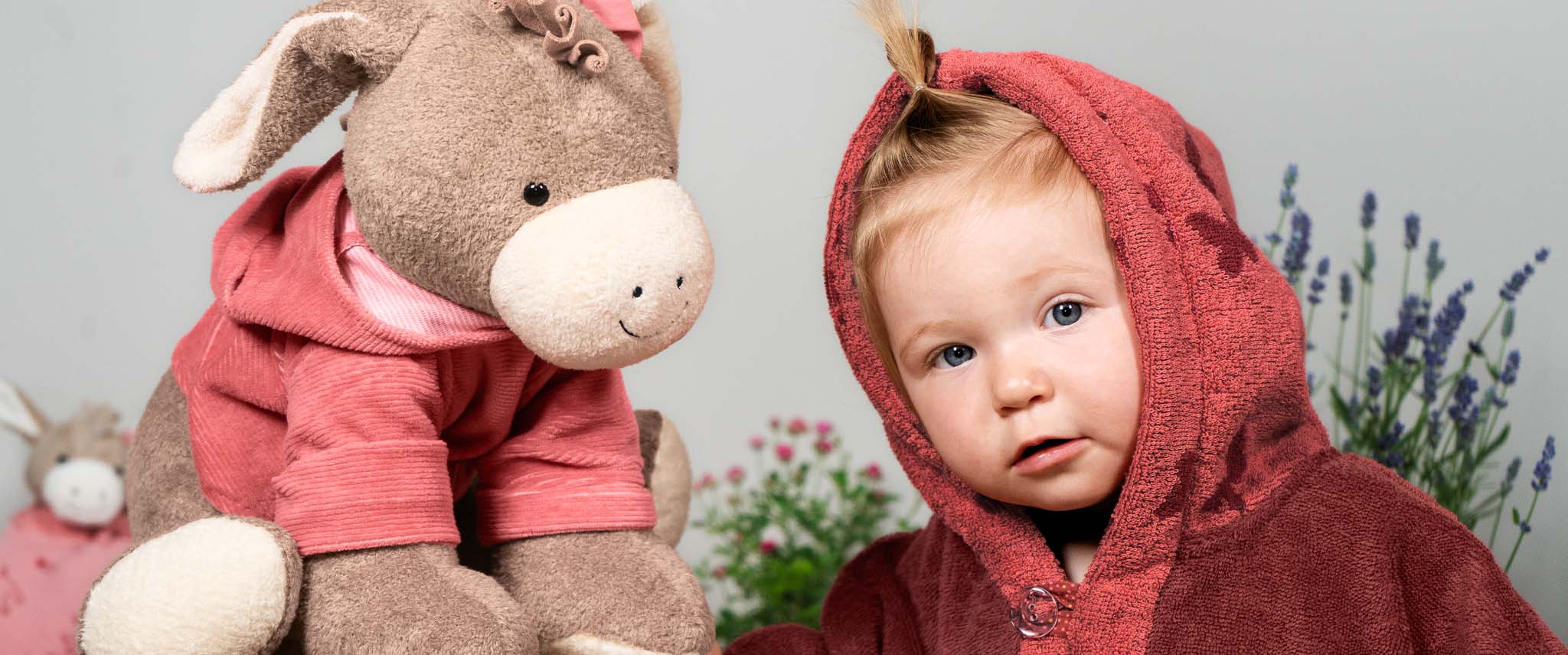Tips for your laundry
Here you will find our recommendations for the correct handling of Sterntaler products.
Before carrying the first
Textiles pass through many hands during production. Therefore, please wash new clothing that comes into direct contact with skin before putting it on your child for the first time.
Before washing
- Close the velcro fasteners (other parts may get caught).
- Closing the zippers ensures that they will work properly later.
- Turn printed or embroidered items inside out before washing! Washing inside out generally preserves the texture and color of the garments.
- Wash removable parts individually.
- Turn inside hoods of jackets inside out.
- Wash multiple pieces of clothing together, as color and texture changes may occur.
Sort laundry
- Sort laundry not only by washing temperature, but also by color. This will prevent unwanted coloring!
- Always wash new clothes with the same colors to avoid excess color!
- Always wash dark clothes separately!
We recommend always washing colored textiles together with clothes in the lightest color.
Basic for stain treatment
- The sooner a stain is treated, the easier it is to remove.
- Always treat the stain before washing.
- For delicate, colored fabrics, first test on inconspicuous areas to see if the color will stick.
- Removing it from the inside prevents the fabric from rubbing.
- Place an absorbent fabric underneath – preferably an undyed one that you change frequently.
- Work from the edge of the stain inward to prevent it from getting bigger.
- After removing the stain, rinse or wash the fabric – this does not apply to non-washable fabrics.
If in doubt, dry clean. - For synthetic paint stains (oil paints, emulsion paints or ballpoint pens) only use special removers.
- Quickly drying cleaned areas prevents the formation of unsightly marks. For example, use a hairdryer.
Spot removal agent
The most versatile stain removers are gall soap, white vinegar, and lemon juice. Nothing more is needed for quick stain removal!
- Blood: Rinse fresh blood stains immediately with cold water! Soak older ones in warm soapy water, or soak stubborn ones in salt water.
- Egg yolk, tomato sauce/ketchup, cocoa: Rub in cold water with gall soap and rinse.
- Chocolate, chewing gum: Place in a plastic bag in the freezer for about 30 minutes, crumble, and brush out. If necessary, treat any residue with gall soap.
- Butter: warm soapy water is sufficient here.
- Bicycle grease, resin, tar: Rub with butter, scrape off and treat with gall soap.
- Felt-tip pen: Immediately rub with yogurt. Otherwise, dab with vinegar and rinse thoroughly.
- Vegetables, fruit, grass: Pretreat with vinegar, then rub in with gall soap and rinse with lukewarm water. Repeat if necessary.
- Fruit juice: Sprinkle salt on the damp stain and shake it out after it dries. Sometimes mineral water helps, too.
- Spinach: Rub with raw potato, then treat with gall soap.
- Wax: Crumble off and iron out between blotting paper.
- Discolored white laundry: Turn it white again with chlorine. Caution: Toxic!
- Paints, glue: Soak before washing.
- Grease, grass: Spray with pre-wash spray before washing.
Wash and protect the environment
- Fill the washing machine completely – protect your laundry and the environment!
- Use appropriate detergents for delicates, coloreds and whites.
- When washing colored laundry, make sure that your detergent does not contain bleach or optical brighteners.
- Wash functional fabrics and fleece with special detergent! This preserves properties like waterproofness and breathability for longer. Waterproofing protects the outer fabric from moisture.
- The dosage of detergent depends on the water hardness and the degree of soiling of the laundry; less is often more!
- Fabric softeners are hardly necessary; functional fabrics and fleece even lose their breathable and waterproof properties!
- Do not spin muddy clothing!
- Rinse swimwear thoroughly with tap water after each swim, as chlorine or salt can quickly destroy the materials.
- Avoid rubbing too hard when hand washing!
After washing
- Never leave colored laundry damp!
- Pull laundry into shape or shake it out well before wind drying or after tumble drying.
Dry on a leash
- Laundry can fade in direct sunlight – it is best to dry inside out.
- Do not let swimwear dry in the sun.
- Turn items with inner lining occasionally to dry faster.
Dry in the tumble dryer
Clothes with a crossed-out dryer symbol should not be tumble dried. They could shrink significantly or pill.
- If the dryer symbol is displayed, you can dry the clothes in the dryer according to the dryer temperature.
- However, the laundry will pill more quickly than line-dried laundry.
- Never put polyester items in the dryer!
Iron
The iron dots on the care label indicate the temperature range. If the iron is crossed out, the fabric should not be ironed. It could become deformed, develop shine, curl, etc.




